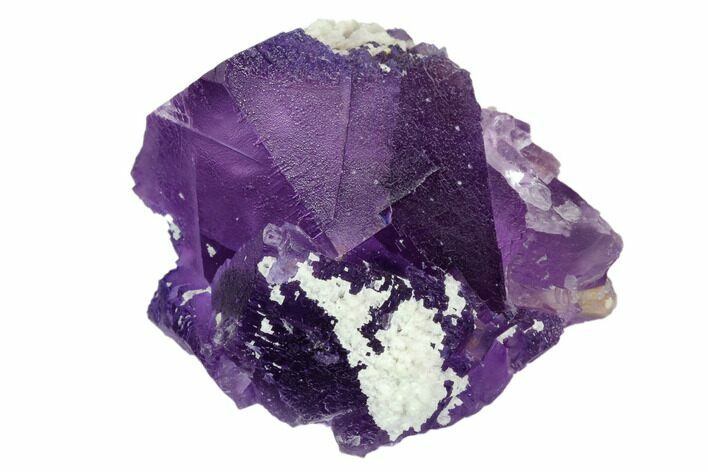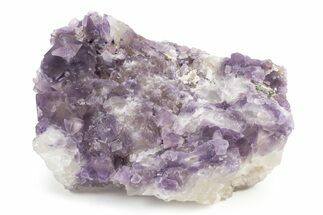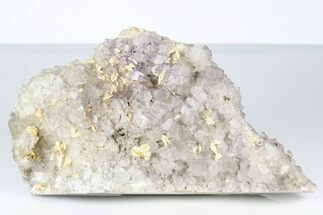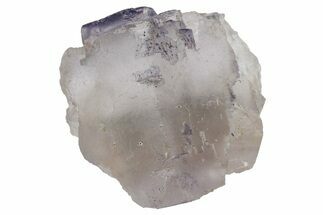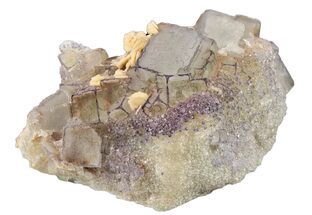This Specimen has been sold.
2.7" Purple Fluorite with Bladed Barite - Cave-in-Rock, Illinois
This is gorgeous purple stepped-cubic fluorite crystal cluster that formed in association with white bladed barite, collected from the Cave-In-Rock district of Harden County, Illinois.
About Fluorite
Fluorite is a halide mineral comprised of calcium and fluorine, CaF2. The word fluorite is from the Latin fluo-, which means "to flow". In 1852 fluorite gave its name to the phenomenon known as fluorescence, or the property of fluorite to glow a different color depending upon the bandwidth of the ultraviolet light it is exposed to. Fluorite occurs commonly in cubic, octahedral, and dodecahedral crystals in many different colors. These colors range from colorless and completely transparent to yellow, green, blue, purple, pink, or black. Purples and greens tend to be the most common colors seen, and colorless, pink, and black are the rarest.
Fluorite is a halide mineral comprised of calcium and fluorine, CaF2. The word fluorite is from the Latin fluo-, which means "to flow". In 1852 fluorite gave its name to the phenomenon known as fluorescence, or the property of fluorite to glow a different color depending upon the bandwidth of the ultraviolet light it is exposed to. Fluorite occurs commonly in cubic, octahedral, and dodecahedral crystals in many different colors. These colors range from colorless and completely transparent to yellow, green, blue, purple, pink, or black. Purples and greens tend to be the most common colors seen, and colorless, pink, and black are the rarest.
Barite, commonly spelled baryte, is well-known for its great range of colors and varied crystal forms and habits. = It is a heavy mineral consisting of barium sulfate, and typically has the chemical formula of BaSO4. The barite group consists of baryte, celestine, anglesite, and anhydrite. It is generally white to colorless and is the main source of barium.
The Cave-In-Rock mining district of Hardin County, Illinois is world renowned for its fluorite, which is widely considered to be some of the highest quality fluorite in the world. The area has a long history of producing spectacular fluorite specimens from several different mines. All of the major mines have been closed for years and the cutoff in supply has sent prices of this material soaring. A recently bored mine is now producing small amounts of material, but hasn't made a dent in demand or prices.
Archaeological discoveries near the Cave-In-Rock mining district found beads and other ornaments made of fluorite, placing use of the stone in the area to about 900 years ago, when the land was inhabited by the Native Mississippian Americans. Early European settlers mining for galena in the 1830s discarded fluorite they mined, since the lead they sought was more valuable at the time. Fluorite found new use in the 1880s in a new steel-furnace technology and demand increased considerably, leading to the emergence of several commercial fluorite mining companies in the Illinois/Kentucky region.
Fluorite is a halide mineral comprised of calcium and fluorine with the chemicla formula CaF2. The word "fluorite" is from the Latin fluo, which means to flow. In 1852 fluorite gave its name to the phenomenon known as fluorescence, or the property of fluorite to glow a different color depending upon the bandwidth of the ultraviolet light it is exposed to.
Fluorite occurs commonly in cubic, octahedral and dodecahedral crystals in many different colors. These colors range from colorless and completely transparent to yellow, green, blue, purple, pink or black. It is most commonly found in purple and/or green.
Archaeological discoveries near the Cave-In-Rock mining district found beads and other ornaments made of fluorite, placing use of the stone in the area to about 900 years ago, when the land was inhabited by the Native Mississippian Americans. Early European settlers mining for galena in the 1830s discarded fluorite they mined, since the lead they sought was more valuable at the time. Fluorite found new use in the 1880s in a new steel-furnace technology and demand increased considerably, leading to the emergence of several commercial fluorite mining companies in the Illinois/Kentucky region.
Fluorite is a halide mineral comprised of calcium and fluorine with the chemicla formula CaF2. The word "fluorite" is from the Latin fluo, which means to flow. In 1852 fluorite gave its name to the phenomenon known as fluorescence, or the property of fluorite to glow a different color depending upon the bandwidth of the ultraviolet light it is exposed to.
Fluorite occurs commonly in cubic, octahedral and dodecahedral crystals in many different colors. These colors range from colorless and completely transparent to yellow, green, blue, purple, pink or black. It is most commonly found in purple and/or green.
SPECIES
Fluorite & Barite
LOCATION
Cave-In-Rock, Harden County, Illinois
SIZE
2.7 x 2.6"
CATEGORY
SUB CATEGORY
ITEM
#128784
 Reviews
Reviews



